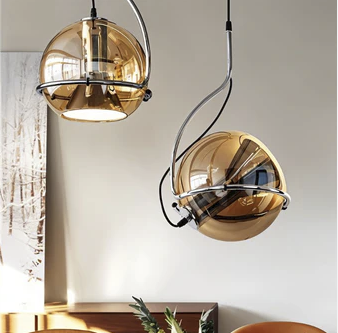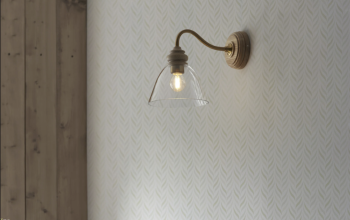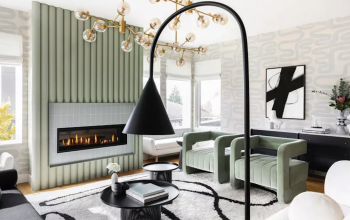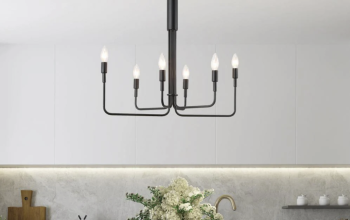The evolution of American retro lighting is a fascinating journey that reflects broader cultural and technological shifts throughout the decades. The term “retro” itself evokes a sense of nostalgia, often harking back to the mid-20th century when design aesthetics began to embrace bold colors, geometric shapes, and innovative materials. The 1920s and 1930s marked the dawn of modernism in America, with lighting designs that emphasized functionality and simplicity.
Art Deco emerged as a prominent style during this period, characterized by its luxurious materials and intricate patterns. As the nation transitioned into the post-war era of the 1940s and 1950s, lighting designs began to take on a more playful and whimsical character, reflecting the optimism of the time. This era saw the rise of iconic pieces such as the Sputnik chandelier and the use of vibrant colors in lamps and fixtures, which became synonymous with American homes.
As the decades progressed, the 1960s and 1970s introduced a wave of countercultural movements that influenced design trends, leading to an eclectic mix of styles. The introduction of plastics and new manufacturing techniques allowed for more experimental forms and colors in lighting design. The popularity of mid-century modernism surged during this time, with designers like George Nelson and Arne Jacobsen creating pieces that are now considered timeless classics.
By the 1980s and 1990s, however, there was a shift towards minimalism and a return to more subdued color palettes. Yet, even as tastes evolved, the charm of retro lighting remained embedded in American culture. Today, vintage-inspired designs are experiencing a renaissance, as homeowners seek to recapture the warmth and character of bygone eras while integrating them into contemporary spaces.
The Appeal of Nostalgic Lighting
The Emotional Connection of Nostalgic Lighting
This emotional connection is a powerful driver behind the resurgence of retro lighting Casatidesign in modern homes. People are increasingly drawn to pieces that tell a story or reflect their personal history, making nostalgic lighting not just a design choice but a meaningful addition to their living spaces. Moreover, the appeal of nostalgic lighting extends beyond personal memories; it taps into a collective yearning for simpler times.
A Reaction Against Modernity
In an age dominated by rapid technological advancements and fast-paced lifestyles, many find comfort in the familiar shapes and colors of retro designs. These pieces often embody craftsmanship and attention to detail that can feel lacking in contemporary mass-produced items. The warmth of incandescent bulbs, the charm of vintage finishes, and the unique silhouettes of retro fixtures create an inviting atmosphere that resonates with those seeking refuge from modern life’s complexities.
A Desire for Authenticity
As such, nostalgic lighting has become more than just a trend; it represents a desire for authenticity and connection in an increasingly digital world.
Modern Twists on Retro Designs
While retro lighting pays homage to the past, contemporary designers are skillfully reinterpreting these classic styles to fit modern sensibilities. This fusion of old and new has led to innovative designs that maintain the essence of vintage aesthetics while incorporating modern materials and technologies. For instance, many contemporary fixtures now utilize energy-efficient LED bulbs that mimic the warm glow of traditional incandescent lights, allowing homeowners to enjoy the nostalgic ambiance without sacrificing sustainability.
Additionally, designers are experimenting with mixed materials—combining metals, glass, and even wood—to create striking contrasts that enhance the visual appeal of retro-inspired pieces. Furthermore, modern twists on retro designs often embrace versatility and adaptability. Many contemporary lighting fixtures are designed with adjustable features or modular components that allow users to customize their lighting experience according to their needs.
This flexibility is particularly appealing in today’s multifunctional living spaces, where lighting must serve various purposes—from task lighting in home offices to ambient illumination in cozy reading nooks. By blending classic forms with innovative functionality, designers are ensuring that retro lighting remains relevant in an ever-evolving design landscape while still capturing the charm that makes these pieces so beloved.
The Importance of Quality Craftsmanship
In an era where mass production often prioritizes speed over quality, the importance of craftsmanship in retro lighting cannot be overstated. High-quality materials and meticulous attention to detail are hallmarks of well-crafted lighting fixtures that stand the test of time. When investing in retro lighting, discerning consumers often seek out pieces that reflect superior craftsmanship—whether it’s a hand-blown glass shade or a meticulously finished metal base.
These elements not only enhance the aesthetic appeal but also contribute to the durability and longevity of the fixtures. A well-made piece can become a cherished heirloom, passed down through generations, further solidifying its place in family history. Moreover, quality craftsmanship extends beyond aesthetics; it also encompasses safety and functionality.
Retro lighting fixtures designed with care often incorporate better electrical components and wiring standards than their mass-produced counterparts. This attention to detail ensures that these fixtures not only look beautiful but also operate safely within modern electrical systems. As consumers become more aware of the importance of sustainability and ethical production practices, they are increasingly drawn to brands that prioritize craftsmanship over quantity.
By choosing high-quality retro lighting, individuals not only enhance their living spaces but also support artisans and manufacturers committed to preserving traditional techniques in an age dominated by disposable goods.
Tips for Incorporating Retro Lighting into Your Home
Incorporating retro lighting into your home can be an exciting endeavor that adds character and warmth to your living spaces. One effective approach is to start with a statement piece—a bold chandelier or an eye-catching floor lamp—that serves as a focal point in your room. This can set the tone for your overall design aesthetic while allowing you to build around it with complementary decor elements.
Consider mixing different styles within your space; for instance, pairing a mid-century modern lamp with contemporary furniture can create an intriguing juxtaposition that highlights both design eras. Additionally, don’t shy away from using multiple light sources at varying heights; layering your lighting can enhance depth and create a cozy atmosphere reminiscent of vintage interiors. Another essential tip is to pay attention to color schemes when selecting retro lighting fixtures.
Many vintage designs feature vibrant hues or unique finishes that can either complement or contrast with your existing decor. For example, a bright yellow pendant light can add a playful touch to a neutral kitchen, while an antique brass lamp can bring warmth to a minimalist living room. Furthermore, consider incorporating dimmer switches for added versatility; this allows you to adjust the brightness according to different moods or activities throughout the day.
Ultimately, the key is to embrace creativity and personal expression when integrating retro lighting into your home—after all, these pieces are not just functional but also serve as reflections of your unique style.
The Environmental Impact of Retro Lighting
The Environmental Benefits of Retro Lighting
As the world becomes increasingly aware of the importance of sustainability, the environmental impact of retro lighting has become a significant consideration. Many vintage lighting fixtures were designed to last, with durable materials and timeless designs that can withstand the test of time. This is in stark contrast to many modern mass-produced items that are often designed for obsolescence or rapid disposal.
Reducing Waste with High-Quality Retro Lighting
By choosing high-quality retro lighting, consumers can reduce waste by investing in pieces that will not only enhance their homes but also stand the test of time. This approach contributes to a more sustainable lifestyle, as it reduces the need for frequent replacements and the waste associated with them. Furthermore, advancements in technology have made it possible for retro-inspired designs to incorporate energy-efficient solutions without compromising their aesthetic appeal.
Energy Efficiency and Sustainable Practices
The shift towards energy-efficient retro lighting not only reduces electricity consumption but also lowers carbon footprints associated with energy production. For instance, LED bulbs are now available in various shapes and color temperatures that mimic traditional incandescent lights while consuming significantly less energy. Additionally, many manufacturers are increasingly focused on sustainable practices, utilizing recycled materials or eco-friendly finishes in their products, further minimizing environmental impact.
Embracing Sustainable Retro Lighting Options
By embracing retro lighting options that prioritize sustainability, consumers can enjoy beautiful designs while making responsible choices for the planet. This approach allows individuals to contribute to a more sustainable future while still appreciating the unique aesthetic appeal of retro lighting.
The Future of American Retro Lighting
The future of American retro lighting appears bright as designers continue to draw inspiration from past eras while embracing contemporary innovations. As consumer preferences shift towards authenticity and sustainability, there is likely to be an increasing demand for vintage-inspired pieces that tell a story or evoke nostalgia. This trend is already evident in the growing popularity of antique shops, flea markets, and online marketplaces dedicated to vintage finds—demonstrating a collective appreciation for unique items with character over mass-produced alternatives.
Furthermore, as younger generations become homeowners, their affinity for retro aesthetics may drive further exploration into mid-century modern designs and other historical styles. In addition to aesthetic trends, technological advancements will undoubtedly shape the future landscape of retro lighting. As smart home technology continues to evolve, we may see more retro-inspired fixtures equipped with modern functionalities such as app-controlled dimming or color-changing capabilities—all while maintaining their classic charm.
This fusion of old-world design with cutting-edge technology will allow homeowners to enjoy the best of both worlds: timeless beauty combined with contemporary convenience. Ultimately, as we look ahead, it is clear that American retro lighting will continue to captivate hearts and illuminate homes for generations to come—bridging past traditions with future innovations in an ever-changing world.



